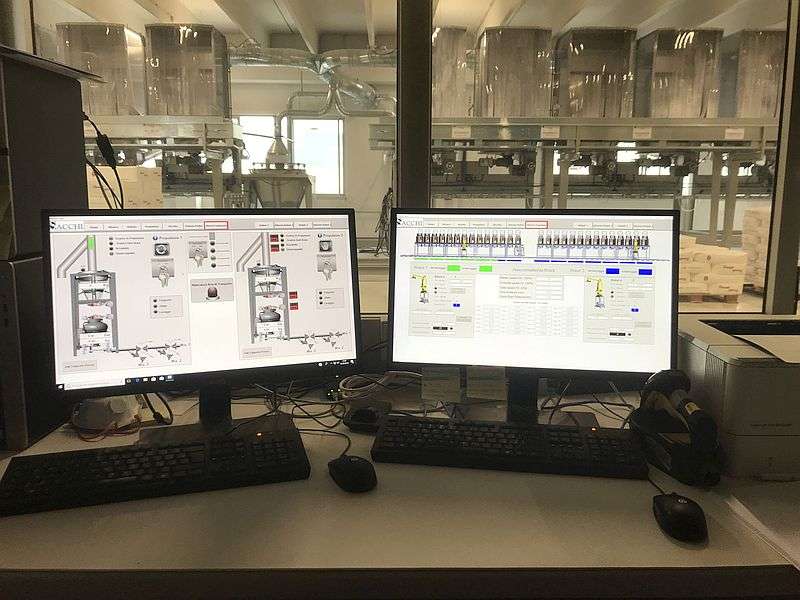
Robotic solution for micro ingredients recipes preparation.
Unlimited flexibility and modularity thanks to multi-patented robotic Smart technology designed by Sacchi.
SmartTipping is a robotic solution for micro ingredients recipes preparation.
Unlimited flexibility and modularity thanks to multi-patented robotic Smart technology designed by Sacchi.
SmartTipping system coordinates dosing of "n" small containers with feeding capabilities into the robot working area, in order to execute the dosing sequence, set in the recipe.
The mini-batch is collected into a bucket or in a bag, codified by bar code printing or by RFID and finally conveyed to the process machines or directly poured into the mixer.
Containers-feeders can be of different types and are selected according to category of products to be dosed.
Containers-feeders can be fixed or removable when necessary (they can be placed in the warehouse and taken back to the production line when necessary)
SmartBatch software manages all the process.
The system can be directly interfaced to the factory MES software using both standard and customized protocols.
SmartBatch comes from 40 years of experience in dosing plants manufacturing and it represents the development in management of components recipes. The batch is based on a database for data creation and storing, a powerful editor for recipes/parameter and an easy intuitive graphic interface.
It mainly concerns the storing of raw materials and components definition and the editing, saving and putting into production of complex recipes.
SmartBatch allows to :
SmartBatch is available on HMI industrial platform or PC based both local and with client server configuration (Windows server) multi station and relational database motor
SmartBatch is multi-protocol and communicates not only with Sacchi plants but also with the industrial PLC of the customer and MES/management softwares
SmarBatch can perfectly integrate with SmartPick and SmartTipping robotic systems, creating an high 4.0 value-added application
Note: SmartBatch Software description mentioned in this page can include optional characteristics not available in basic version
If you are looking for more productivity, high quality or waste reduction, the solution is only one: robotic automation.
ROBOTS INCREASE COMPETITIVENESS
To survive in global market, companies have to focus on supply-chain total costs, products quality, productivity and marketing times: these are the factors that make the robotic a good investment.
To compete with low-cost countries, the best solution is no more the production outsourcing: to extend the supply-chain, with all the logistical problems resulting from this choice, can neutralise the costs saving in short time. For this reason, today, many companies chose the robotic automation to improve quality and productivity.
Speed, repeatability and accuracy are the main benefits coming from robotics. Whether you are speaking of working a component, welding or packing pharmaceutical products, the robots can do the work in the fastest way and get high and uniform quality. That’s why they can be perfectly integrated in almost all phases of industrial processes.
ROBOTS INCREASE PROFITABILITY
Investment on robotic system can be written off in short time. Making a direct comparison with manual work on same production amount, it’s possible to see that a profit on the capital invested for the robotic system is gained after few years. If also the productivity profits, achieved normally by a robotic system, are included, payback time of the capital is even shorter.
Robot prices are cheaper; they can offer not only better performance, quality and flexibility, but can be reassigned according to new production requirements.
ROBOTS ARE FLEXIBLE
It’s possible to use only one robot to do multiple operations, among which cutting, welding and finishing, in order to reduce general cycle time, increase quality and achieve a faster payback of invested capital. In comparison to traditional productive automation, robots offer further benefits such as high flexibility, faster replacement and a more important surplus value to processes when running secondary operations.
Thanks to sophisticated software, robots can be reset off-line, allowing the quick start of new products without being forced to stop the production in progress.
ROBOTS CAN ALWAYS WORK
Robots work 24 hours per day. Robot cells can be very compact and therefore occupy a reduced production space.Robots can operate in extreme environment conditions, such as dangerous areas or clean rooms. In conclusion, robots reduce significantly the operating costs and contemporaneously increase the production.
